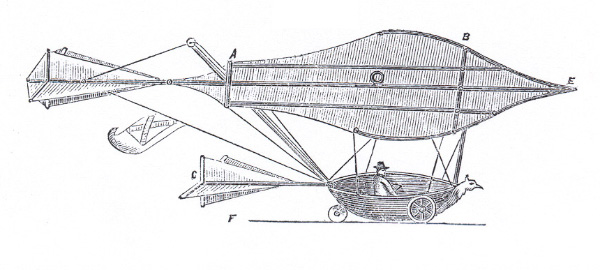
|
 |
||||||
|---|---|---|---|---|---|---|---|
| Sir George Cayley The Father of Aviation by Larry Dwyer |
 |
 |
 |
 |
 |
||
 |
 |
 |
 |
 |
|||
 George Cayley and his 1849 "Boy Carrier." |
||
|
George Cayley (1773-1857) was a relatively well to do baron, who lived on an estate in Yorkshire, England and is considered the "Father of Aviation". An educated man, Cayley spent his life working intensely on engineering, social, and political problems in England. However, the dominant interest of his life was heavier-than-air flight and in 1799, he set forth for the first time in history, the concept of the modern airplane. Cayley had identified the drag vector (parallel to the flow) and the lift vector (perpendicular to the flow). It was this concept that would be utilized by the Wright Brothers in the first successful airplane more than a century later.
1
In 1804, Cayley built a whirling arm apparatus just as John Smeaton (1724-1792) had done earlier to study the resistance of air on cloth surfaces.2 At the end of this whirling arm, a lifting surface (a portion of a wing) was used to measure the force of lift. Also in 1804, he designed, built, and flew a small model glider, which represented the first modern configuration airplane in history. It included a fixed wing, a horizontal and vertical tail that could be adjusted. He found that setting the wings at a slight dihedral gave the glider lateral stability and that a tail plane set behind the main wings gave longitudinal stability.3 This was the discovery of Inherent Stability that, although demonstrated but not fully understood by Cayley, would be theorized in greater detail by Alphonse Pénaud.4 In 1809 and 1810, Cayley published three papers on his aeronautical research where he quite correctly pointed out for the first time that:
• 1. Lift is generated by a region of low pressure on the upper surface of the wing. These results, among many others, can be found in his papers entitled, On Aerial Navigation published in the November 1809, February 1810, and March 1810 issues of Nicholson's Journal of Natural Philosophy.5 This "triple paper" by Cayley ranks as one of the most important aeronautical documents in history.6 In 1849, he designed, built, and tested a full-size triplane glider, which during some of its tests carried a ten-year-old boy through the air several yards on a descending hill. For this reason, the machine is often referred to as the Boy Carrier. One of Cayley's other designs appeared in Mechanics Magazine in 1852.7 Cayley never achieved his final goal of sustained heavier-than air, manned flight, but his contributions clearly furthered advancement of the modern airplane. |
End Notes:
|
1. John D. Anderson, Jr. Inventing Flight: The Wright Brothers and Their Predecessors. (Baltimore, Maryland: The John Hopkins University Press, 2004) 2. Beril Becker. Dreams and Realities of the Conquest of the Skies. (New York: Atheneum, 1967). 37. 3. Josephy Jr. and Alvin M. ed. The American Heritage History of Flight. (New York: Simon & Schuster, 1962). 80. 4. Peter L. Jacob. Visions of a Flying Machine, The Wright Brothers and the Process of Invention. (Washington, D.C.: Smithsonian Institution, 1990). 29. 5. Beril Becker. 46. 6. John D. Anderson, Jr. 7. Sir George Cayley. Sir George Cayley's Governable Parachutes: Mechanic's Magazine, Museum, Register, Journal, and Gazette. ed. J. C. Robertson. (London, 1852) 241-244. |
© The Aviation History On-Line Museum. All rights reserved.
Created November 22, 2009. Updated May 30, 2015.